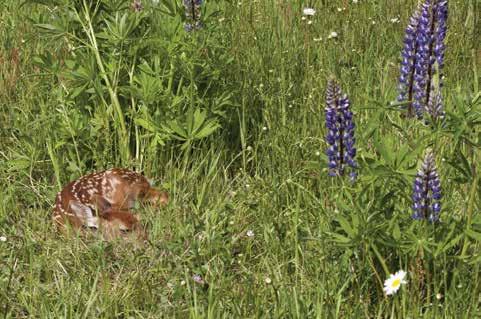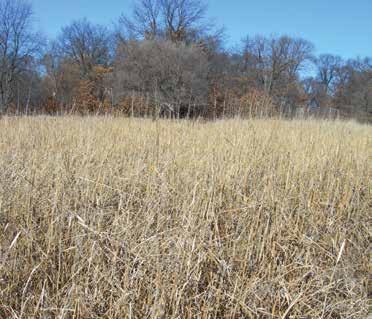
7 minute read
Planting Grass Cover for Whitetails
Many of us get into managing whitetails because we enjoy hunting them - we wanted to attract more whitetails to our property. But what happens when you build a “restaurant” (plant food plots), but don’t also erect a “motel” or “someplace nearby to stay?” Answer: typically your results won’t be what you expected or meet the possible potential of the spot. All of the “extra mouths and stomachs” that you just “invited” are going to need fawning cover, escape concealment and a place to stay. Planting grasses is a tactic that I believe can show fast, significant results.
Native warm season grasses (NWSG) will need a year to establish and maybe a couple to really begin to shine, so these stands should be thought out and planned in advance. This is one good thing about annual grasses – they are fast, inexpensive cover!
Advertisement
However, planting native warm season grasses (NWSG) are one of the tactics that I believe can show fast (well … a couple of years), significant and long-lasting results. Ask a property owner who has been in Conservation Reserve Program, Conservation Reserve Enhancement Program, Wildfire and Hurricane Indemnity Program, or one of the native grass restoration programs provided by the FSA or NRCS (Farm Service Agency or Natural Resources Conservation Service), how effective these perennial grass stands can be for providing cover to whitetails.
The type of cover that will work best for you will depend upon your region, topography and the type of habitat you currently have. Whitetails are very adaptable and live in many different types of habitat classifications. Timber stand improvement; planting trees, shrubs or grasses; disking to stimulate native seed banks; and using fire can all be productive ways of creating the “edge cover” and diversity that whitetails love – and I suggest that a property manager consider all of the above.
If you’re in a heavily timbered area and have a mature stand with a closed canopy, then a chainsaw will probably produce the greatest, fastest results. If your property is located in farmland, marshland, riparian zone, rural area or new growth, then grasses (annual and/or NWSG perennials) can make a huge impact on how many deer are actually residing on your property.
Native grasses are one thing missing from many properties throughout the whitetails’ range - in the areas where native grass stands have historically grown oftentimes nowadays they are absent. Some choose to enlist the help of the NRCS or FSA and go strictly by the book. I highly recommend this - the NRCS will be a wealth of information and help. If you specifically want a “native grass restoration” this is a good idea, particularly if you have no experience. But if you simply want “housing” for your whitetails, this can be a “do-ityourself” project.
I keep mentioning “NWSG,” which are mainly perennials, but some of my favorite grasses are annuals like millets, different varieties of sorghum, Peredovik sunflower, Egyptian wheat, and sometimes corn and various annual or biannual legumes. Yes, I know these aren’t all grasses.
My favorite perennials include big bluestem, little bluestem, Indian grass, several varieties of switchgrass, Illinois bundleflower, side oats grama and several legumes. Obviously, not all of these are grasses, some are forbs and legumes. Many of the NWSG plants will grow in clumps rather than a thick mat, allowing for other plants like legumes to take root. The grasses will, in turn, love the nitrogen that the legumes produce.
I have tested different mixtures and blends over the years and have had good luck with most of them. Even blends of all annuals help promote fast, inexpensive “housing” for your herd and game birds.
The perennials, on the other hand, are NOT cheap, but a little can go a long way and can last for years. Several great blends can be found on the Nativ Nursery website (www.nativnurseries. com) along with help to understand planting them.
Good annual grass stands can be produced with many different recipes and ratios of plants, but if you want to make it easy, use some Blind Spot. It doesn’t get any easier than this. It was designed to help conceal blind locations and create screening cover. But guess what? If it will conceal a blind, it will also conceal a whitetail … very well I might add.
BioLogic’s Blind Spot will grow five to seven feet tall (or taller) in a couple of months; it’s simple to plant and can establish even during dry summer conditions. When specifically planting for whitetail cover, I like to mix some Egyptian wheat, maybe some other grain sorghum and sometimes even millet or corn. Most of these are tall, sturdy stalks that withstand the elements fairly well.
Got turkeys? After maturity, these grasses drop their seeds that upland birds and turkeys love. Whitetails also eat a lot of the seed before it drops. When it does drop, you will often get regrowth for the following year. Certain profound seed-producing annuals like millet, sorghum or Egyptian wheat may be prevalent for years. When the seed heads mature, they will release thousands of seeds, and those that aren’t consumed by your wildlife are potential new plants for your stand.
I have tried planting both annuals and perennials (NWSG) together, with mixed results. The annuals shoot up fast so I have a source of cover for my herd during the first year, and they (the annuals) sometimes seem to provide “structure” for the perennials as they develop. The annual seeds also help to evenly distribute some of the light, fluffy perennial seeds. Seed/plant choice is crucial for this tactic and, again, I would refer you back to the NRCS if I were spending the money on perennials.


Still standing strong – here we see a stand of annual grasses after several months of wind, rain and snow cover.
You will want to prepare a flat, firm seedbed. These seeds can be broadcast but a drill will be more efficient, especially with the perennials. Most of these seeds will have a planting depth of a quarter inch or less. If broadcasted, make sure to use a cultipacker to ensure good seed-to-soil contact.
The ultimate would be a seeder specifically designed for NWSG plantings. Sometimes your county soil services office or local wildlife organization, such as a branch of Quality Deer Management Association or National Wild Turkey Federation may have one to rent. If using a drill, you must be careful because some cannot be calibrated to evenly disperse these sometimes fluffy, odd-shaped seeds. Getting a bag of some of these NWSG seeds is more like receiving a pillow than a bag of seed.
If your equipment is limited and you need to broadcast, you must also be cautious here because the fluffy, lightweight or odd-shaped seeds will sometimes need a “carrier,” or a way to disperse the seeds evenly. Some people use pelletized lime or fertilizer mixed with the seed to help it broadcast evenly.
Even if you plant with a seeder specifically designed for NWSG, you’ll likely still need to use “filler” or aggregate because of the different sizes and shapes of the various seeds and the seeding rates for each.
Make sure to fertilize well when you plant if you’re using annuals, because once the grasses get tall it will be difficult to fertilize a second time.
The second year (starting in the spring), fertilizer should be applied again to perennials. Often you’ll get a second regrowth from seed-drop off of the annuals. Sometimes running a disk through last year’s annual grasses can create more thick edges and a stand that isn’t all uniform height and thickness.

If you’re mixing your own grass blend, think about the job you’ll want them to accomplish. The varieties in a blend for bedding may be different than mixing a blend to screen an area from view. If a visual screen is your goal, many like to mix in the annual, Egyptian wheat. It has a sturdy stalk and can grow 10 to 12 feet tall in a couple months.
Mowing can also help to create more irregular edge cover, which is great for whitetails, turkeys and other wildlife.
For NWSG stands, after the second or third year you will want to treat the stand with fire. Burning during the spring will help to remove clutter and promote new growth on your NWSG, which in turn encourages wildlife utilization. Make sure NOT to burn during fawning or when your hens are nesting. A prescribed burn should be done every two to three years. Even if you cannot burn, in my opinion, an unmaintained grass stand is better than no grass stand at all!
There are many tactics we can employ to enhance habitat for whitetails, but planting grasses can be one of the fastest producing and bestow some of the biggest payback. Not only for whitetails, many species love these grass stands. As long as you prepare properly, use sound planting procedures and maintain the crop correctly, you can realize the benefit of these “miracle grasses” and give your whitetails, turkeys and loads of other critters quick, efficient “housing.”







